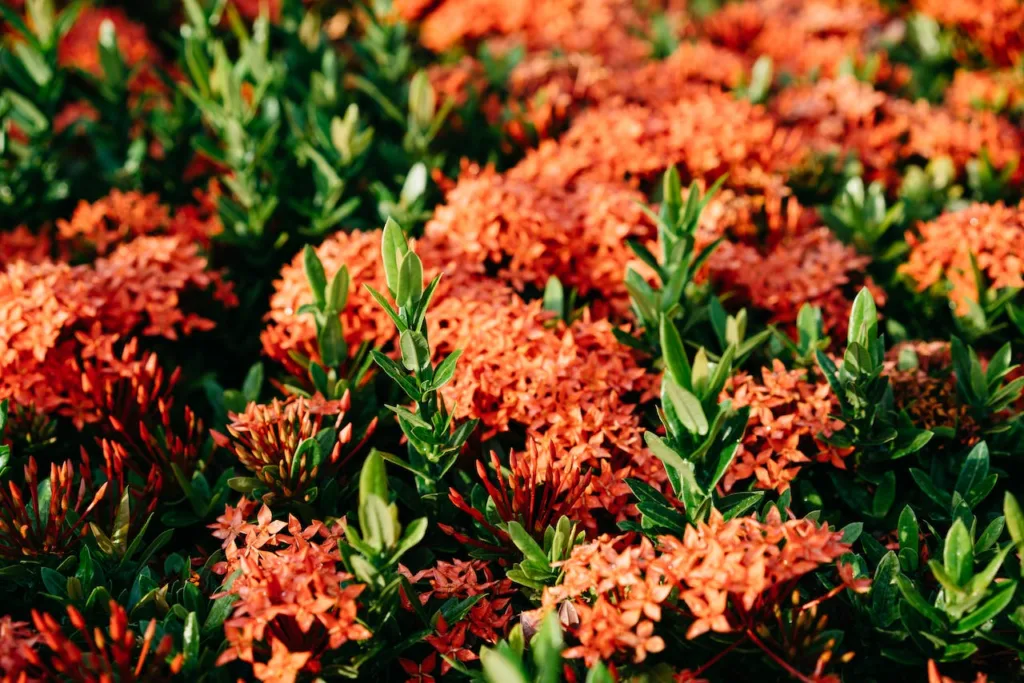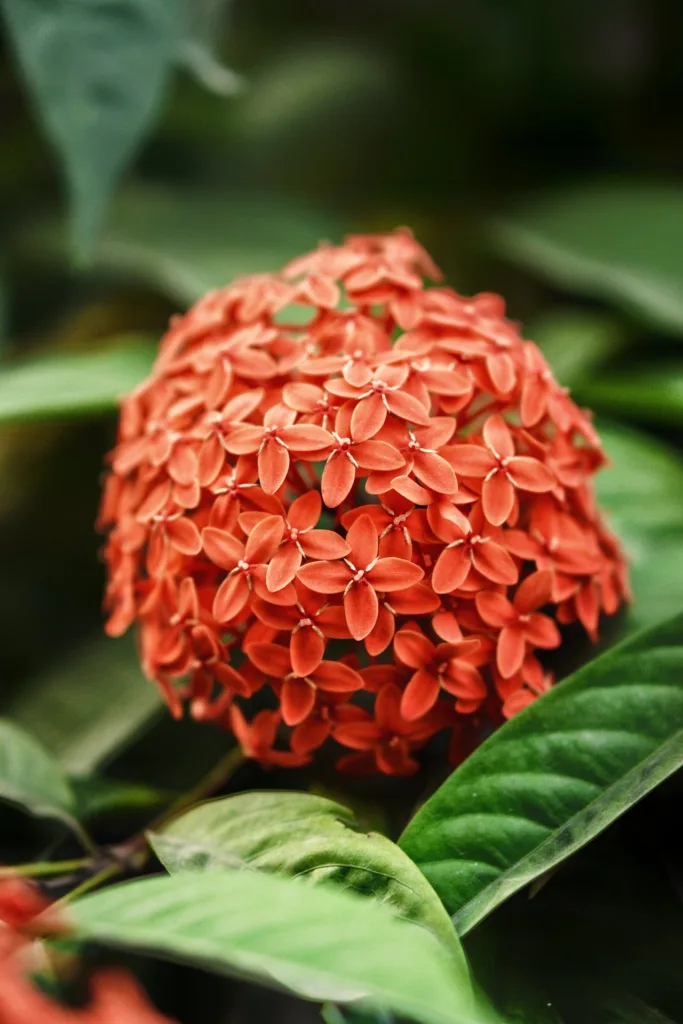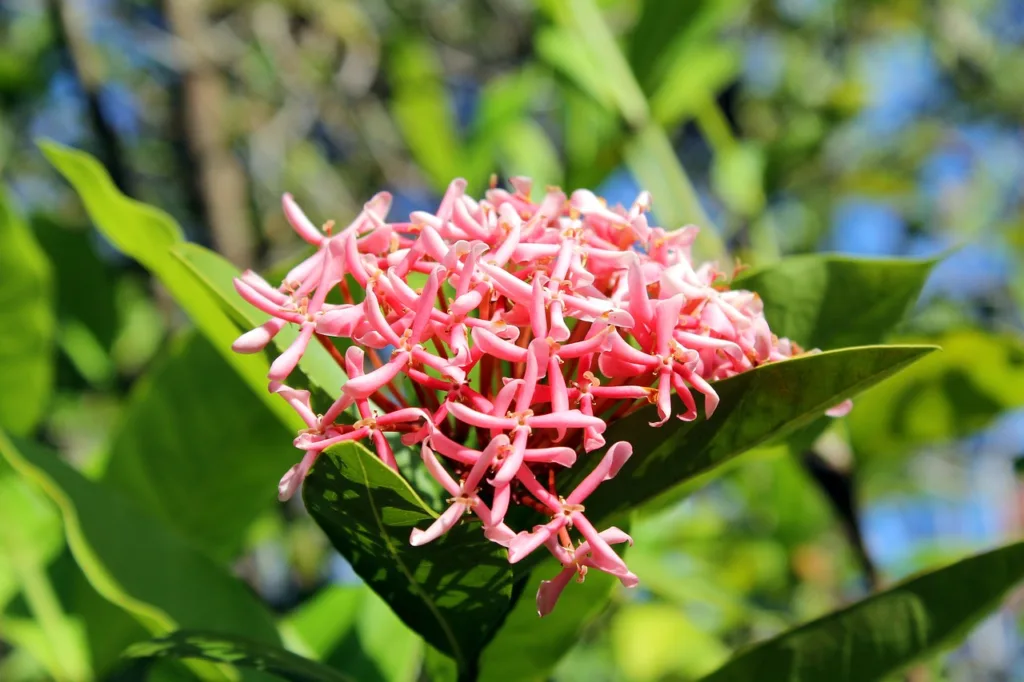Are you looking to add a touch of vibrant color and exotic beauty to your garden or indoor space? Look no further than the stunning Ixora chinensis.
This evergreen shrub, native to Asia, is renowned for its striking clusters of vibrant flowers and glossy, dark green foliage.
Whether you’re a seasoned gardener or just starting, this comprehensive guide will walk you through everything you need to know about growing and caring for ixora chinensis.
Ixora Chinensis: Adding Exotic Beauty to Your Garden
Imagine stepping into your garden and being greeted by a burst of vibrant colors. With its brilliant flower clusters that range in hues from fiery reds and oranges to delicate pinks and whites, the ixora chinensis is the perfect addition to any garden landscape.
Not only does it add an exotic touch, but it also attracts butterflies and hummingbirds, creating a whimsical and enchanting atmosphere. But where do you start when it comes to growing and caring for this stunning plant?
| Attribute | Details |
|---|---|
| Kingdom | Plantae |
| Division | Angiosperms |
| Class | Eudicots |
| Order | Gentianales |
| Family | Rubiaceae |
| Genus | Ixora |
| Species | chinensis |
| Common Name | Chinese Ixora, Rangan, Ranganathan |
| Native Range | Southeast Asia, India |
| Habitat | Tropical and subtropical regions |
| Growth Form | Shrub |
| Height | 4 to 6 feet (1.2 to 1.8 meters) |
| Leaves | Glossy, elliptical, opposite |
| Flowers | Clusters of small, tubular, colorful flowers (red, pink, orange) |
| Blooming Season | Throughout the year |
| Sunlight | Full sun to partial shade |
| Soil | Well-draining, acidic to neutral soil |
| Watering | Regular, moderate watering |
| Uses | Ornamental, landscaping, garden decoration |
| Special Features | Attractive flowers, evergreen foliage |

Choosing the Right Location for Ixora Chinensis
Before you begin planting Ixora chinensis, it’s crucial to choose the right location. This plant thrives in tropical or subtropical climates.
So if you live in an area with cold winters, you may need to consider growing it indoors or in a greenhouse.
Ixora chinensis prefers full sun to partial shade, so make sure to select a spot that receives at least six hours of direct sunlight each day.
Preparing the Soil of Ixora Chinensis
Ixora chinensis prefers well-draining soil that is rich in organic matter. Before planting, it’s essential to prepare the soil properly.
Start by removing any weeds or debris from the area. Then, mix in compost or well-rotted manure to improve the soil’s fertility and drainage. Aim for a pH level between 5.5 and 6.5, as ixora chinensis prefers slightly acidic soil.
Planting Ixora Chinensis of Ixora Chinensis
Once you’ve prepared the soil, it’s time to plant your ixora chinensis. Dig a hole that is twice as wide and just as deep as the plant’s root ball.
Gently remove the ixora chinensis from its nursery container, being careful not to damage the roots. Place it in the hole, making sure that the top of the root ball is level with the surrounding soil. Fill in the hole with soil, firm it gently, and water thoroughly.
Watering and Fertilizing of Ixora Chinensis
Proper irrigation is crucial for the healthy growth of Ixora chinensis. During the first few weeks after planting, make sure to water your plant thoroughly to help establish its root system.
After that, Ixora chinensis requires regular watering, especially during dry spells. Monitor the soil moisture and water when the top inch feels dry.
Fertilizing Ixora chinensis is also important for optimal growth. Apply a balanced, slow-release fertilizer in early spring and again in mid-summer.
Follow the manufacturer’s instructions regarding dosage and application methods. Avoid over-fertilizing, as it can lead to excessive leaf growth and fewer blooms.
Pruning and Maintenance for Ixora Chinensis
Regular pruning will help maintain the shape and promote healthy growth of your ixora chinensis. Prune after the flowering season, which is typically in late spring or early summer.
Remove any dead, damaged, or overgrown branches to encourage new growth and enhance the overall appearance of the plant.
In addition to pruning, ixora chinensis requires regular maintenance to keep it in top condition. Keep an eye out for pests such as aphids, scale insects, or mealybugs.
If infestations occur, treat them promptly with organic insecticides or horticultural oils. Regularly check the foliage for signs of disease, such as leaf spots or fungal infections, and take appropriate measures to prevent their spread.
Ixora Chinensis Propagation
If you want to expand your ixora chinensis collection or share its beauty with others, propagation is a simple and rewarding process. The most common methods of propagation include stem cuttings and air layering.
To propagate Ixora chinensis through stem cuttings, select a healthy stem with at least three nodes. Remove the lower leaves and dip the cut end in the rooting hormone.
Place the cutting in a well-draining soil mix and keep it moist until root development occurs. In a few weeks, you’ll have a new ixora chinensis to nurture and enjoy.
For air layering, select a mature branch with a healthy node. Make a small incision just below the node and wrap it with damp sphagnum moss.
Cover the moss with plastic wrap and secure it with twine. After a few weeks, roots should form in the moss. Cut below the rooted section and plant it in a container or on the ground.

Common Varieties of Ixora Chinensis
Ixora chinensis is a versatile plant with several popular varieties to choose from. Here are a few noteworthy examples:
- Ixora chinensis ‘Nora Grant’: Known for its deep red flowers, this variety is a favorite among gardeners for its striking color and compact growth habit.
- Ixora chinensis ‘Freckle Face’: This eye-catching variety features clusters of vibrant pink flowers with contrasting yellow centers, creating a beautiful mosaic effect.
- Ixora chinensis ‘Dwarf Singapore Pink’: As the name suggests, this dwarf variety produces lovely pink flowers and is perfect for smaller spaces or container gardening.
Conclusion: Embrace the Exotic Beauty of Ixora Chinensis
Now armed with the knowledge of how to successfully grow and care for ixora chinensis, it’s time to bring this exotic beauty into your garden or indoor space.
Remember to choose the right location, prepare the soil adequately, and provide the necessary care in terms of watering, fertilizing, pruning, and maintenance.
With a little time and effort, you’ll be rewarded with a stunning display of vibrant flowers and lush foliage that will delight both you and your guests.
So go ahead, embrace the exotic beauty of Ixora chinensis, and create a garden that is bursting with vibrant colors and enchanting fragrances. Happy gardening!
FAQs
What is Ixora chinensis used for?
Ixora chinensis, commonly known as Chinese Ixora, is often used as an ornamental shrub in gardens and landscapes.
It is cultivated for its attractive clusters of vibrant flowers, which come in various colors including red, pink, and orange.
What is the Indian name for Ixora chinensis?
Ixora chinensis is commonly known as “Rangan” or “Ranganathan” in India.
Does Ixora need full sun?
Yes, Ixora plants generally thrive in full sun to partial shade. They prefer well-lit conditions for optimal growth and flowering.
Is Ixora plant good for home?
Ixora can be a beautiful addition to gardens and outdoor spaces around homes, providing colorful blooms and lush foliage.
In tropical and subtropical regions, Ixora can also be grown indoors as a potted plant, but it requires adequate light and care to flourish.

